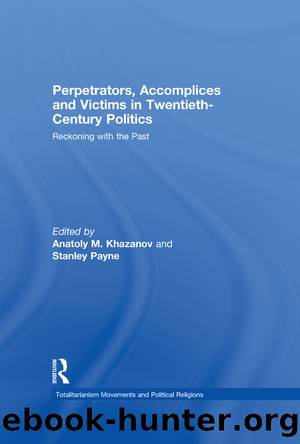Perpetrators, Accomplices and Victims in Twentieth-Century Politics by Anatoly M. Khazanov Stanley Payne

Author:Anatoly M. Khazanov, Stanley Payne [Anatoly M. Khazanov, Stanley Payne]
Language: eng
Format: epub
ISBN: 9781317989967
Barnesnoble:
Publisher: Taylor & Francis
Published: 2013-09-13T00:00:00+00:00
Notes
1.
Charles S. Maier, âOvercoming the Past? Narrative and Negotiation, Remembering, and Reparation: Issues at the Interface of History and the Lawâ, in John Torpey (ed.), Politics and the Past. On Repairing Historical Injustices (New York: Rowman & Littlefield, 2003), p.296.
2.
See, for example, Steven Rosefielde, âAn Assessment of the Sources and Uses of Gulag Forced Labor 1929â56â,Soviet Studies 33 (1981), pp.51â87; Rosefielde, âIncriminating Evidence: Excess Deaths and Forced Labor under Stalin â A Final Reply to Criticsâ, Soviet Studies 39/2 (1987), pp.292â313; Robert Conquest,The Great Terror: A Reassessment (Oxford: Oxford University Press, 1990); Edwin Bacon, The Gulag at War: Stalinâs Forced Labor System in the Light of the Archives (New York: New York University Press, 1994); A.N. Dugin, Neizvestnyi GULAG: Dokumenty i fakty (Moscow, 1999); A.I. Kokurin and N.V. Petrov (eds), GULAG: Glavnoe upravlenie lagerei. 1918â1960 (Moscow: Materik, 2000); Michael Ellman, âSoviet Repression Statistics: Some Commentsâ, Europe-Asia Studies 54/7 (2002), pp.1151â1172; Alexander N. Yakovlev, A Century of Violence in Soviet Russia (New Haven, CT: Yale University Press, 2002), pp.233â234; Anne Applebaum, Gulag. A History (New York: Doubleday, 2003), p.578ff.; Barry McLoughlin and Kevin McDermott (eds), Stalinâs Terror. High Politics and Mass Represssion in the Soviet Union (Basingstoke: Palgrave Macmillan, 2003); and many others.
3.
The latter numbered over 6 million â see P. Polian, and N. Pobol, Stalinskie deportatsii 1928â1953 godov. Dokumenty (Moscow: Materik, 2005), pp.12â13.
4.
Some 6 million people â see G. M. Ivanova,Labor Camp Socialism. The Gulag in the Soviet Totalitarian System (Armonk, NY: M. E. Sharpe, 2000), p.43.
5.
John Keep, âWheatcroft and Stalinâs Victims: Commentsâ, Europe-Asia Studies, 51/6 (1999), p.1091.
6.
Nanci Adler, Victims of the Soviet Terror. The Story of the Memorial Movement (Westport, CT: Praeger, 1993), p.100ff.; David Remnik, Leninâs Tomb. The Last Days of the Soviet Empire (New York: Random House, 1993); Kathleen E. Smith, Remembering Stalinâs Past. Popular Memory and End of the USSR (Ithaca, NY: Cornell University Press, 1996), p.78ff.
7.
Arkady B. Tsfasman, âStalin in Soviet and Russian History Textbooks from the 1930s to the 1990sâ, in Jerzy W. Borejsza and Klaus Ziemer (eds), Totalitarian and Authoritarian Regimes in Europe. Legacies and Lessons from the Twentieth Century (New York: Berghahn Books, 2006), p.561ff.
8.
Lev Gudkov, Negativnaia identichnost (Moscow: Novoe Literaturnoe Obozrenie, 2004), p.83ff.
9.
P. G. Pikhoia, Sovetskii Soiuz: Istoriia vlasti (Moscow: Izdatelâstvo PAGS, 1998), pp.167â8.
10.
See, for example, Boris Diakov, Povestâ o perezhitom (Moscow: Sovetskaia Rossiia, 1966).
11.
I. Sirotinskaia, âDolgie-dolgie gody besedâ, in V.V. Esipov (ed.), Shalamovskii sbornik, vyp.1. (Vologda: Izdatelâstvo Instituta povysheniia kvalifikatsii i perepodgotovki pedagogicheskikh kadrov, 1994), pp.134â5.
12.
Anne Applebaum, âAfter the Gulagâ,The New York Review of Books, October 24 (2002), p.40.
13.
Marina Loskutova, âO pamiati, zritelânykh obrazakh, ustnoi istorii, i ne tolâko o nikhâ, Ab Imperio,1 (2004), pp.76â7.
14.
For their analysis, see Leona Toker,Return from the Archipelago. Narratives of Gulag Survivors (Bloomington, IN: Indiana University Press, 2000).
15.
V. A. Kozlov and S. V. Mironenko (eds),Kramola. Inakomyslie v SSSR pri Khrushcheve i Brezhneve. 1952â1982 (Moscow: Materik, 2005), p.28ff.
16.
James V. Wertsch, Voices of Collective Remembering (Cambridge: Cambridge University Press, 2002), p.68.
17.
Smith (note 8), pp.166â7.
18.
Pikhoia (note 9), 1998, pp.129â30.
19.
Albert Van Goudoever, The Limits of Destalinization in the Soviet
Download
This site does not store any files on its server. We only index and link to content provided by other sites. Please contact the content providers to delete copyright contents if any and email us, we'll remove relevant links or contents immediately.
The Vikings: Conquering England, France, and Ireland by Wernick Robert(79207)
Ali Pasha, Lion of Ioannina by Eugenia Russell & Eugenia Russell(39936)
The Vikings: Discoverers of a New World by Wernick Robert(36828)
The Conquerors (The Winning of America Series Book 3) by Eckert Allan W(36714)
Cecilia; Or, Memoirs of an Heiress — Volume 1 by Fanny Burney(32083)
Cecilia; Or, Memoirs of an Heiress — Volume 3 by Fanny Burney(31476)
Cecilia; Or, Memoirs of an Heiress — Volume 2 by Fanny Burney(31431)
Empire of the Sikhs by Patwant Singh(22778)
Hans Sturm: A Soldier's Odyssey on the Eastern Front by Gordon Williamson(18338)
The Secret History by Donna Tartt(18247)
Cat's cradle by Kurt Vonnegut(14798)
Sapiens: A Brief History of Humankind by Yuval Noah Harari(14004)
Pimp by Iceberg Slim(13817)
Talking to Strangers by Malcolm Gladwell(12909)
Norse Mythology by Gaiman Neil(12875)
Leonardo da Vinci by Walter Isaacson(12828)
Underground: A Human History of the Worlds Beneath Our Feet by Will Hunt(11854)
4 3 2 1: A Novel by Paul Auster(11831)
The Radium Girls by Kate Moore(11644)
